by Gillian Rosenberg, Communications Coordinator, Women of Holy Blossom

Androgynous is in some ways like men, and in some ways like women, and some ways like both men and women and in some ways neither like men nor women.
(Mishnah Bikkurim 4, sourced from keshetonline.org )
About 3 years ago, Women of Holy Blossom (WHB) embarked on a renewal journey that entailed new branding around the value of inclusion. In living up to that branding, however, we struggled with gender diversity. Particularly this: How do we, as a female group, welcome, embrace and celebrate those who identify as gender fluid, transgender, agender, and non-binary? While our challenge was initially intended to benefit individuals who have been, for the most part, marginalized from synagogue life, we soon recognized that WHB would be strengthened by such diversity, that we needed this community as much as they might need us.
So, we contacted Keshet. If you don’t know Keshet (meaning rainbow in Hebrew) and the exceptional work they do, you really should visit their website. In a nutshell, they advance the full and equal participation of LGBTQ+ Jews and their families in Jewish life, through education, advocacy, allyship, and leadership – primarily in the United States. At the end of November, WHB’s Leadership Council; our programming partner, Women’s Advocacy Group; and the Holy Blossom staff and clergy who support our work, met online with Rabbi Micah Buck-Yael, Keshet’s Director of Education and Training, for an enlightening, inspiring, and validating learning session.
The outcome? We now have a conceptual framework for gender diversity in a female context, known as affinity spaces. We understand WHB to be an affinity space for those who seek female experiences and are comfortable centering female voices and needs. Yet, within every affinity space, there is diversity regarding the many ways in which we identify, including gender. Whatever gender identity one brings to the WHB affinity space is an asset to WHB.
Additionally, we are more confident using the language of gender diversity; recognizing microaggressions against gender-expansive, genderqueer, and gender-nonconforming people; and engaging in difficult and uncomfortable discussion on where we fall short and how we can (and must) do better in supporting the needs of this community. We are primed for allyship, advocacy, and seeking justice at Holy Blossom Temple and in local and global Jewish communities.
Sisterhood was created at Holy Blossom Temple to provide opportunities for women to engage in and contribute to the synagogue community because women were generally marginalized from doing so at the organizational level. One hundred years later, Women of Holy Blossom is continuing this legacy by bringing another marginalized group into the fold. Our journey is just beginning and there is much still to learn and do. But we are driven forward by our obligation as Jews. Our sacred texts recognize multiple gender identities, and they instruct us, in various ways, to lift up the vulnerable. Taken together, these messages light a pathway to gender diversity in a female space. WHB is rolling up sleeves and digging in. Follow us on social media to see how.
It is not your duty to finish the work, but neither are you at liberty to neglect it.
(Pirkei Avot 2:16, sourced from Sefaria.org)













